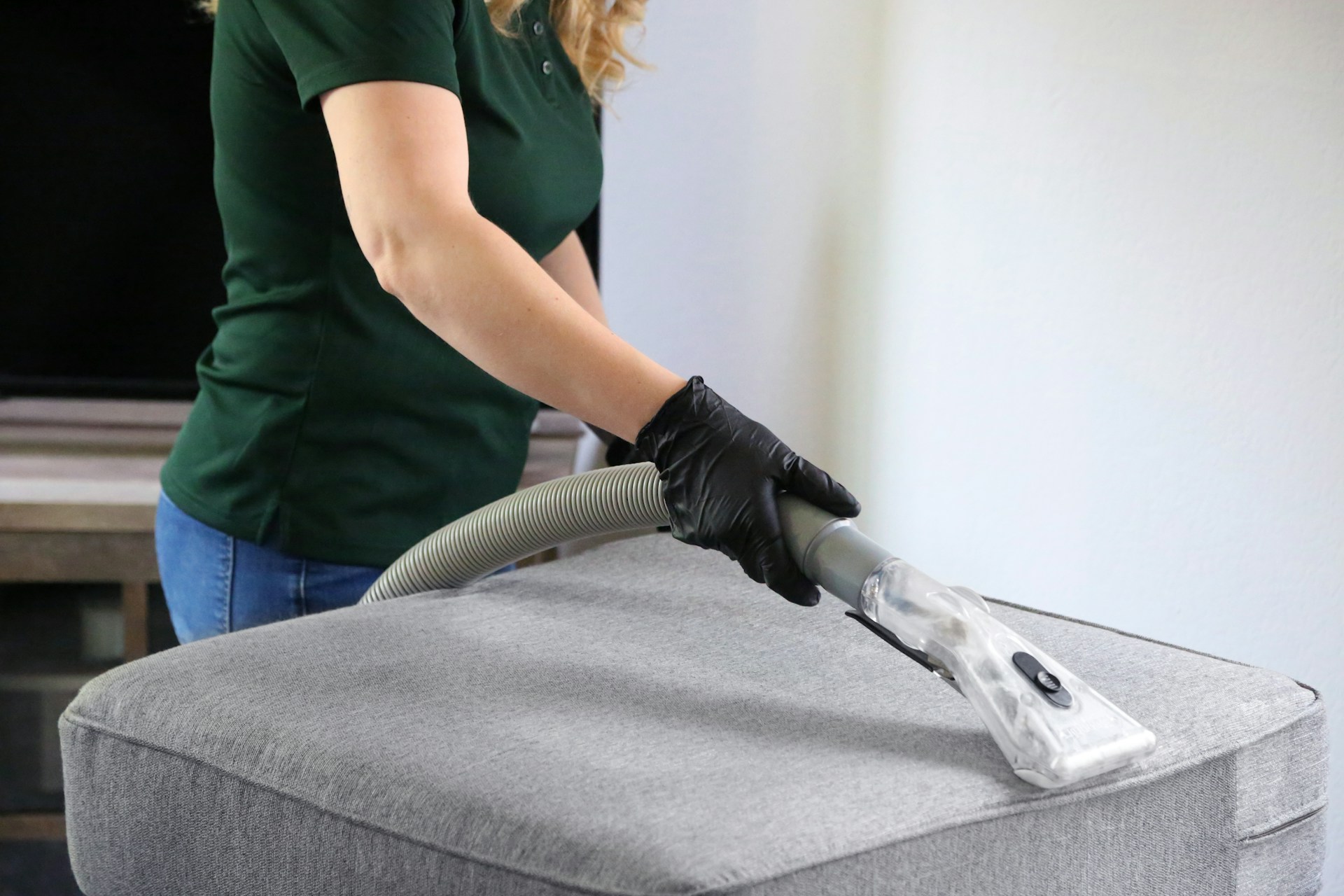Keeping your microfiber sofa clean is essential for maintaining its appearance and extending its lifespan. Microfiber is a popular material for sofas due to its durability and softness, but it can attract dirt and stains if not properly maintained. In this comprehensive guide, we’ll walk you through the best methods for cleaning and caring for your microfiber sofa.
Microfiber Sofas
Microfiber is a type of synthetic fiber that is created from a combination of polyester and polyamide. This blend results in fibers that are extremely fine, even finer than silk, which contributes to their soft and luxurious feel. The fine fibers are densely woven together, which gives microfiber its signature smooth texture and makes it an excellent choice for upholstery. The tight weave of the fibers also contributes to its durability and resistance to dust and spills, making it a practical choice for furniture.
One of the standout characteristics of microfiber is its ability to mimic the feel of natural fabrics while offering superior performance. The fine threads make it exceptionally soft to the touch, which adds a level of comfort to any piece of furniture covered with it. Additionally, the density of the weave not only enhances the fabric’s strength but also helps in repelling dust and liquid spills, which can easily be wiped off without leaving a stain.
Moreover, the synthetic nature of microfiber means that it can be produced in a wide range of colors and textures, providing endless options for home decor. Whether you prefer a sleek modern look or a more traditional feel, microfiber can be tailored to suit various styles, making it a highly versatile material for furniture design.
Benefits of Microfiber Sofas
Microfiber sofas are lauded for their numerous benefits, making them a popular choice for households. One of the primary advantages is their durability. The tightly woven fibers create a strong and resilient fabric that can withstand daily wear and tear, which is especially important in busy households with children or pets. This durability ensures that a microfiber sofa can maintain its appearance and structural integrity for many years.
Another significant benefit is the fabric’s stain resistance. The tight weave of microfiber helps to prevent liquids and dirt from penetrating the surface, making spills easy to clean with just a cloth or a mild cleaning solution. This property is particularly beneficial for families or individuals who entertain frequently, as it helps keep the sofa looking clean and new with minimal effort. Additionally, microfiber is less prone to pilling and fraying compared to other fabrics, further contributing to its low-maintenance appeal.
Ease of maintenance is also a key selling point for microfiber sofas. Regular vacuuming and occasional spot cleaning are typically all that is needed to keep the fabric in excellent condition. Unlike some other materials that require special treatments or professional cleaning, microfiber can be managed with simple at-home care routines. This convenience, combined with the fabric’s aesthetic and practical benefits, makes microfiber a highly desirable option for sofa upholstery.
Common Issues with Microfiber
Despite its many advantages, microfiber is not without its challenges. One common issue is the appearance of water spots. When liquids spill on microfiber and are not cleaned up properly, they can leave visible rings or spots on the fabric. This can be particularly noticeable on darker colors and can detract from the overall appearance of the sofa. It’s important to use proper cleaning techniques to avoid water spots and maintain the sofa’s pristine look.
Accumulation of dirt and oils over time is another concern. While microfiber is resistant to dust and spills, it can still collect dirt and body oils, especially in high-use areas like the armrests and seats. These substances can build up and cause the fabric to look dingy if not cleaned regularly. Routine maintenance, such as vacuuming and spot cleaning, is essential to prevent this buildup and keep the sofa looking fresh and clean.
Additionally, microfiber can sometimes develop a texture issue known as “crushing.” This occurs when the fibers become matted down and lose their softness and fluffiness, often due to heavy use or improper cleaning techniques. To combat this, it’s recommended to regularly fluff and brush the fabric to maintain its texture. Understanding these common issues and how to address them can help in preserving the beauty and longevity of a microfiber sofa.
Preparing for Cleaning
Check the Manufacturer’s Tag
Before embarking on the cleaning process for your microfiber sofa, it is crucial to check the manufacturer’s tag. This tag, usually located underneath the cushions or on the underside of the sofa, contains valuable information regarding the recommended cleaning methods and any specific restrictions. The tag typically includes cleaning codes such as “W” for water-based cleaners, “S” for solvent-based cleaners, “S-W” for both, and “X” for vacuum only. Adhering to these guidelines is essential to avoid damaging the fabric and to ensure that you are using the appropriate cleaning methods.
Ignoring the manufacturer’s instructions can lead to adverse effects on the fabric, such as discoloration, shrinkage, or weakening of the fibers. By carefully reading and following the instructions, you can choose the right cleaning agents and techniques that will effectively clean your sofa without causing harm. This initial step is a preventive measure that can save you from costly repairs or replacements down the line.
Additionally, checking the manufacturer’s tag provides peace of mind, knowing that you are taking the correct approach to maintain the quality and appearance of your microfiber sofa. It’s a simple yet crucial step that sets the foundation for successful and safe cleaning.
Gather Necessary Cleaning Supplies
To clean your microfiber sofa effectively, you will need to gather a few basic cleaning supplies. Having these items ready before you start will make the process smoother and more efficient. Here’s a list of essential supplies you’ll need:
- Vacuum Cleaner with a Brush Attachment: A vacuum cleaner is essential for removing dust and debris from the sofa. The brush attachment helps to lift dirt from the fabric without causing damage.
- White Cloths or Sponges: Use white cloths or sponges to prevent any color transfer onto the microfiber. These are used for blotting and cleaning stains.
- Mild Soap or Dish Detergent: A mild soap solution can be used to clean water-based stains. It’s gentle enough to avoid damaging the fabric.
- Rubbing Alcohol: This is effective for tackling tougher stains like ink or dye. It evaporates quickly, reducing the risk of water spots.
- Baking Soda: Useful for absorbing odors and cleaning oil-based stains. It’s a natural and non-toxic cleaning agent.
- Spray Bottle: A spray bottle allows you to apply cleaning solutions evenly over the stained area without soaking the fabric.
- Soft-Bristled Brush: A soft-bristled brush is useful for fluffing the fabric after cleaning, helping to maintain its texture and appearance.
By having these supplies on hand, you can ensure that you are prepared to tackle any cleaning task effectively. Each item plays a specific role in the cleaning process, contributing to the overall success of maintaining your microfiber sofa.
Safety Precautions
When cleaning your microfiber sofa, it’s important to take certain safety precautions to protect both the fabric and yourself. Here are some key steps to follow:
- Test Cleaning Solutions: Always test any cleaning solution on a small, inconspicuous area of the sofa first. This helps ensure that the solution does not cause discoloration or damage to the fabric. Allow the test spot to dry completely before proceeding with a larger area.
- Avoid Colored Cloths or Sponges: Use white or neutral-colored cloths and sponges for cleaning. Colored items can transfer dye onto the microfiber, leading to stains and discoloration. Using white cloths ensures that no additional color is added to the fabric during cleaning.
- Ventilation: Ensure that the room is well-ventilated when using cleaning products, especially those containing alcohol or other chemicals. Proper ventilation helps to disperse any fumes and provides a safer cleaning environment. Open windows or use fans to maintain good air circulation.
By following these safety precautions, you can clean your microfiber sofa effectively while minimizing the risk of damage to the fabric and ensuring your safety. Taking these steps also helps to maintain the integrity and appearance of your sofa, allowing you to enjoy its comfort and aesthetic appeal for years to come.
Routine Maintenance
Regular Vacuuming
Regular vacuuming is essential for maintaining the cleanliness and appearance of your microfiber sofa. Dust, dirt, and debris can accumulate on the surface and in the crevices of the sofa, leading to a dull and dirty appearance over time. Using a vacuum cleaner with a brush attachment is ideal for this task. The brush attachment helps lift dirt from the fabric without causing damage or abrasion to the delicate microfiber.
When vacuuming, pay special attention to the seams and crevices of the sofa where dust and debris tend to accumulate. These areas can often be overlooked but are crucial in preventing dirt buildup. A thorough vacuuming session at least once a week will help keep your sofa looking fresh and new.
It’s also important to vacuum the underside of the cushions and the sofa base. These areas can harbor dust and allergens, which can affect indoor air quality and contribute to allergies. Regular vacuuming not only maintains the sofa’s appearance but also promotes a healthier living environment.
Spot Cleaning
For minor spills and stains on your microfiber sofa, quick action is key to preventing permanent damage. When a spill occurs, use a white cloth to blot (not rub) the stain immediately. Blotting helps absorb the liquid without pushing it deeper into the fabric, which can make the stain harder to remove.
If a mild soap solution is needed, mix a few drops of mild dish detergent with warm water. Dampen a white cloth with the solution and gently blot the stained area. Be careful not to soak the fabric, as excessive moisture can lead to water spots or mildew. After blotting with the soap solution, use a clean cloth dampened with water to rinse the area thoroughly. This helps remove any soap residue that could attract more dirt.
Once the spot cleaning is complete, blot the area dry with a clean, dry cloth. Allow the fabric to air dry completely before using the sofa. This method is effective for most minor spills and stains and helps maintain the sofa’s overall appearance and longevity.
Deep Cleaning Methods
For more thorough cleaning, consider using a mild soap solution. Mix a few drops of mild soap or dish detergent with warm water. Dampen a white cloth with the solution and gently blot the stained area, avoiding soaking the fabric. Rinse with a clean cloth and water, then blot dry to prevent water spots.
For tougher stains, rubbing alcohol can be an effective solution. Fill a spray bottle with rubbing alcohol and lightly spray the stained area. Blot with a white cloth, as rubbing alcohol evaporates quickly and is less likely to leave water spots compared to water-based solutions.
Steam cleaning is another deep cleaning method that can be used if recommended by your sofa’s manufacturer. Follow the instructions on your steam cleaner and use it sparingly to avoid saturating the fabric. Steam cleaning can effectively remove deep-seated dirt and stains, refreshing the sofa’s appearance.
Removing Stains
Tackling Water-Based Stains
Water-based stains can be tricky but manageable if addressed promptly. Start by blotting the stain immediately with a dry cloth to absorb as much of the liquid as possible. This step is crucial to prevent the stain from setting into the fabric. If the stain persists, prepare a mild soap solution by mixing a few drops of mild dish detergent with warm water.
Dampen a white cloth with the soap solution and gently blot the stained area. Be sure not to soak the fabric, as excessive moisture can lead to water spots or other damage. After blotting with the soap solution, use a clean cloth dampened with water to rinse the area thoroughly, ensuring all soap residue is removed.
Finally, blot the area dry with a clean, dry cloth and allow it to air dry completely before using the sofa. This method is effective for most water-based stains and helps maintain the overall appearance and longevity of your microfiber sofa.
Handling Oil-Based Stains
Oil-based stains require a different approach due to their greasy nature. Start by sprinkling baking soda on the stain and letting it sit for 15-20 minutes. Baking soda is excellent for absorbing oil and lifting it from the fabric. After the baking soda has had time to work, vacuum the area to remove the powder and absorbed oil.
If the stain remains, mix a mild soap solution with warm water. Dampen a white cloth with the solution and gently blot the stained area. As with water-based stains, avoid soaking the fabric. Rinse the area with a clean cloth and water to remove any soap residue, and then blot dry with a clean, dry cloth.
Allow the area to air dry completely before using the sofa. This method effectively removes oil-based stains while preserving the integrity of the microfiber fabric, ensuring your sofa remains clean and attractive.
Removing Ink and Dye Stains
Ink and dye stains can be particularly stubborn, but they can be removed with patience and the right technique. Start by dabbing a cotton ball with rubbing alcohol. Gently blot the stained area with the cotton ball, being careful not to rub, as this can spread the ink and make the stain worse.
Continue blotting with rubbing alcohol until the stain begins to lift. It may take several attempts, so be patient and persistent. Once the majority of the stain is removed, use a clean cloth dampened with water to rinse the area and remove any remaining alcohol residue.
Finally, blot the area dry with a clean, dry cloth and allow it to air dry completely before using the sofa. This method can effectively remove ink and dye stains from microfiber, restoring the fabric’s appearance without causing damage.
| Cleaning Method | Materials Needed | Steps | Precautions |
| Regular Vacuuming | Vacuum cleaner with brush attachment | Vacuum entire sofa, paying attention to crevices | Use brush attachment to avoid damage |
| Spot Cleaning | White cloth, mild soap, water | Blot stain, apply soap solution, rinse, dry | Avoid soaking the fabric |
| Using a Mild Soap Solution | White cloth, mild soap, water | Blot stain with solution, rinse, dry | Test on a small area first |
| Cleaning with Rubbing Alcohol | Rubbing alcohol, white cloth | Spray alcohol on stain, blot, dry | Use in well-ventilated area, avoid inhaling fumes |
| Steam Cleaning | Steam cleaner | Follow manufacturer’s instructions | Use sparingly to avoid fabric saturation |
| Tackling Water-Based Stains | Dry cloth, mild soap, water | Blot stain, apply soap solution, rinse, dry | Avoid soaking the fabric |
| Handling Oil-Based Stains | Baking soda, vacuum, mild soap, water | Apply baking soda, vacuum, blot with soap solution | Test on a small area first |
| Removing Ink and Dye Stains | Rubbing alcohol, cotton ball, water | Blot stain with alcohol, rinse, dry | Avoid rubbing the stain |
By following these detailed steps and utilizing the summary table, you can effectively maintain and clean your microfiber sofa, ensuring it remains in excellent condition for years to come.




